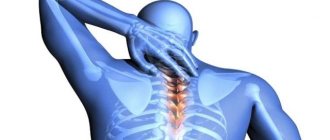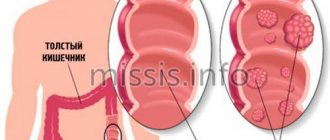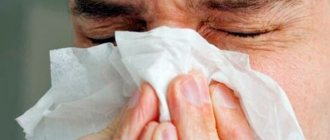Sciatica - symptoms and treatment. Drugs and folk remedies for inflammation of the sciatic nerve.
In medical terms, sciatica is pinching or inflammation of the sciatic nerve (hence the second name of the disease - sciatic neuralgia). The main cause is a herniated disc, but it may be the formation of vertebral osteophytes, spinal tumors, spondylolisthesis, hypothermia, infectious diseases, sudden movements, or heavy lifting.
Sciatica - symptoms
All signs of sciatica boil down to prolonged pain. It can be acute or aching at the initial stage. The specificity of the sciatic nerve is such that it stretches almost along the entire body, starting from the spine and along the entire leg. Pain can occur in the lower back, buttocks, back of the thigh, lower leg, during movement or when sitting. Pain can be caused by a muscle that tightly pinches the nerve. If left untreated, reflexes, sensitivity, and movement may be impaired. In children, symptoms are mild and develop gradually.
Symptoms
It is not difficult to identify sciatica: the symptoms of the disease are well expressed and cannot be ignored . At the initial stage, the pathology manifests itself as follows:
- The primary symptom is acute pain, which intensifies when walking or turning the body. Initially, discomfort is felt only in the lower back, gradually shifting to the hips and gluteal muscles;
- Painful sensations have a mirror effect: muscle numbness occurs on the side opposite to the pinching. This syndrome may be accompanied by tingling, and sometimes mobility is completely impaired;
- Any inflammatory processes in the body are accompanied by an increase in body temperature. When the sciatic nerve is pinched, the thermometer readings usually do not exceed 38°C, the temperature is easily reduced with antipyretics;
- In particular cases, sciatica exacerbates the sensitivity of skin areas in the area of inflammation;
- Marked lameness.
Despite the fact that you can diagnose the symptoms of sciatica and begin treating the pathology yourself at home, if the sciatic nerve is pinched, it is still better not to self-medicate, but to seek medical help. If the pathology is caused by a chronic disease, the patient will need complex therapy, which includes physiotherapy, medication, reflexology, and massage. It is not possible to perform such a health complex at home.
Sciatica - treatment
If the sciatic nerve is pinched, physical activity must be avoided. Treatment for sciatica, inflammation of the sciatic nerve, involves bed rest and drug treatment in combination with other types, including folk remedies. It is possible to prescribe spa treatment and treat sciatica at home. The treatment of inflammation of the sciatic nerve itself is discussed with the attending physician and is possible only if all his requirements are met.
The list of non-traditional remedies includes apitherapy, hirudotherapy (with special placement of medicinal leeches), mud therapy, and osteopathic methods. Physiotherapy, acupuncture, and acupuncture are widely used. Sciatica can be diagnosed using computed tomography, electroneuromyography, magnetic resonance imaging, and radiography. In serious and advanced cases, surgery is needed.
How to avoid relapse of the disease
Sciatica can be cured, but it is equally important to learn how to prevent recurrence. If you manage to relieve the attack of pain, then you need to take into account that unpleasant symptoms may return in the near future. To avoid this, the following requirements must be observed:
- Do not sit in a sitting position for more than two hours;
- Avoid uncomfortable shoes;
- Include multivitamin complexes or foods rich in B vitamins in your daily diet;
- Do not slouch, try to place your feet straight when walking;
- Avoid sleeping on your back. The best option is on the side;
- Follow a diet - extra pounds increase the load on the spinal column.
Having understood the features of the pathology, you can move on to ways to eliminate pinched sciatic nerve at home.
Sciatica – drug treatment
Non-steroidal anti-inflammatory drugs are used in the treatment of sciatica. These medications provide a stable therapeutic effect:
- elimination of inflammation;
- removal of swelling;
- short-term or long-term pain relief.
Medical treatment of the sciatic nerve includes the use of steroidal anti-inflammatory drugs. They are chosen even when non-steroidal drugs do not provide the desired effect. The dosage form of the drugs can be any: suppository, capsule, tablet. Depending on the patient’s overall tolerance to a particular medicinal substance, a course of treatment is selected that will provide maximum effect.
Ointment for sciatica
It is mainly used in the lumbar region. Ointment for sciatica is good for pain relief and inflammation because it acts locally and does not have negative effects on other organs of the body. There are a sufficient number of ointments that treat and alleviate the symptoms of sciatica. They are divided according to their mode of action:
- local non-steroidal anti-inflammatory drugs;
- chondroprotectors (used for osteochondrosis);
- homeopathic ointments (call on the body to actively counteract the disease);
- distracting and irritating drugs;
- combination drugs.
Injections for sciatica
Steroidal anti-inflammatory medications are used for this purpose. Injections for sciatica are prescribed if the disease has taken an acute form. Their advantage is that they are effective, do not cause much harm to the body, and have few side effects. Treatment with injections minimizes the risk of intoxication or poisoning of the body. This medicine acts much faster than others at the site of inflammation. Sciatica - the symptoms and treatment of this disease should only be determined by a doctor based on all examinations.
Painkillers for sciatica
Painful attacks due to sciatica can be very severe and constantly disturb (the pain makes it impossible to sleep). All tablets must be prescribed by a doctor after conducting appropriate examinations. Only he can prescribe the correct medication, dosage, and duration of treatment. Painkillers for sciatica due to pinching or inflammation of the sciatic nerve are very important; their task is to block prostaglandins (substances responsible for pain). There are many such painkillers and they have different active ingredients. The most famous of them:
- Ibuprofen;
- Analgin;
- Ketoprofen;
- Diclofenac;
- Piroxicam et al.
Exercises for sciatica
Exercises are effective in treating sciatica, but absolute caution must be used in movements. Therapeutic exercises for sciatica are useful, effective and prevent blood stagnation. There are several types of therapeutic exercises, including standing and lying exercises. To perform them, no special training or readiness for intense physical activity is required:
- Exercises while lying down. Performed by bending the legs at the knees. You need to lie on your back, pulling your knees as close to your chest as possible, while you need to clasp your buttocks with your hands and hold the position for about 30 seconds.
- Exercises while sitting. In a sitting position on the floor, you need to stretch your legs forward, while smoothly placing your hands behind your back, connecting your shoulder blades. Repeat up to 5 times.
- Exercise while standing. Standing on the floor, you need to put your feet shoulder-width apart, and then raise one hand up and lower the other down. Raising your arms one by one, you need to bend in different directions.
Causes of sciatica
The disease does not occur on its own, but is usually a consequence of the effects of other pathologies on the human body, especially the spine. Among the causes of sciatica are the following:
- Infectious neuritis. Some diseases can cause infectious damage to the nerve, which occurs due to exposure to toxic substances formed during the course of these diseases. Such diseases include: syphilis, typhoid, tuberculosis, malaria and other diseases that contribute to the widespread spread of internal purulent infections.
- Intoxication. Due to exposure to certain poisons or alcohol. There are also cases of inflammation of the nerve by substances that the body itself produces, as a result of damage by diseases such as diabetes or gout.
- There are causes of nerve inflammation that are not related to the spine. One of them is muscle spasms of the pelvic-sacral region, in particular the piriformis muscle.
- Intervertebral hernia of the lumbar region. The formation of a hernia is accompanied by displacement of the vertebral discs, which can result in pinching of the nerve endings of the spinal cord, as a result of which the sciatic nerve can become inflamed.
- Spinal diseases. As a result of some pathologies (osteochondrosis, osteoarthritis of the intervertebral joints), bone formations form on the intervertebral discs, which can have a compressive effect on the spinal nerve endings.
- Postpartum complications, as well as complications during pregnancy. During pregnancy, the bone structure of the pelvic-sacral region is subject to an unbalanced load, which can provoke pathological processes in a body that is not physically prepared for increased loads on the spine.
Folk remedies for treating sciatica
Healers and herbalists treat the disease using various means:
Warming compresses dilate blood vessels, causing a rush of blood to the sore spot, which helps relieve inflammation.
- With bee honey: make a cake from heated wax, apply it to the sore spot, cover with parchment or film. Wrap a blanket warmly on top. After the compress you need to lie down for several hours;
- With cabbage leaves: Place a few cabbage leaves in boiling water for a minute or two to soften them. When the temperature becomes acceptable, apply them to the sore spot, cover with cellophane, wrap warmly with a woolen scarf;
- With black radish: remove the skin from the radish and grate it on the finest grater to make a paste. Cover the lower back with a cloth, place the radish on it, cover with the cloth again. Cover all this with parchment and wrap it in a warm blanket. This compress is kept for 15 minutes, it is better to do it twice a day;
- With rye dough: pour water into rye flour and knead the dough. Form it into a 1 centimeter thick cake, place it on the lower back, cover with film on top and secure. Wrap a woolen scarf over everything;
- With potatoes and horseradish root: grate the horseradish root and potatoes, add a little honey. Form a flat cake. Wrap the flatbread in gauze, place it on the lower back, and cover with film. Wrap in a woolen scarf.
Glass jars are placed on the lower back the old way - using Vaseline and fire.
You can massage with silicone cups: apply massage cream to the lower back, squeeze the jar (to let the air out), and press it tightly to the lower back. Make circular and spiral movements with the suction jar.
Rubbing
Rubbing relieves pain, warms, and improves blood circulation. Let's figure out how to cure it and answer the question “is it possible to apply Colanchoe ointment for sciatica?”
- Bear lard: village healers advise rubbing the lower back with bear lard every day for sciatica (four weeks);
- Agave juice: wash the leaf, remove the thorns, cut into two cakes. Rub the cut into the sore spot 1 or twice a day;
- Vodka with salt: mix a glass of vodka, a glass of honey, a spoonful of salt and five glasses of radish juice. Mix everything. The mixture must be shaken before each grinding. It is advisable to rub your lower back twice a day;
- Ointment with Kalanchoe: take 150 grams of liquid honey, 200 ml of good vodka and 70 ml of Kalanchoe juice. Mix all. At night, apply ointment to the sore spot, cover with foil and wrap warmly with a blanket. In the morning, wash off the ointment. Repeat the procedure for 7–9 days without a break;
- With aloe and hot pepper: aloe leaf, a spoonful of crushed celandine, a pod of red hot pepper, pour a glass of vodka or moonshine. Infuse for a week. Rub the sore spots every day;
- Lilac ointment: grind dry lilac buds into powder. Take pork fat in volume 4 times greater than the volume of the kidneys. Mix and heat in a water bath until the mixture becomes homogeneous. The medicinal ointment should be rubbed in three times a day.
Tinctures and decoctions
Decoctions relieve inflammation, spasms and muscle pain:
- Calendula infusion: pour a spoonful of the raw material into a glass of boiling water and leave to brew for 2 hours. Drink a quarter glass before meals;
- Horse chestnut decoction: pour fresh leaves with water (0.5 liters), cook for a quarter of an hour. Drink a quarter glass four times a day;
- Infusion of pine buds: brew two tablespoons of the raw material with 500 ml of boiling water, let it brew for 12 hours. Drink 100 ml several times a day;
- Decoction of aspen leaves: pour young aspen leaves (1 spoon) with water (250 ml), boil for half an hour. Drink two spoons of the drug 4 times a day.
More recipes for treating the sciatic nerve with folk remedies:
The pharmaceutical industry offers a huge number of fast-acting drugs. But it is always useful to remember the old, time-tested folk methods, and treating sciatica at home will help you.
Symptoms and treatment of sciatica at home.
The main cause of pain is damage (systematic irritation or pinching) of the nerve roots of the sciatic nerve or itself. This problem can develop due to various pathologies in the body. Most often, the immediate cause of pinching is a herniated disc. It puts pressure on the nerve and causes irritation. Sciatica can also develop as a result of bone formation in the vertebral joints, which appears with osteochondrosis or spondyloarthrosis.
Other causes of sciatica can also be misalignment of the vertebrae (in medicine called spondylolisthesis), inflammation, or spasm of the muscles of the lower back or buttocks. Sometimes pain appears due to injuries (including during childbirth), neoplasms, internal bleeding, and long-term diseases of infectious etiology. Sciatica can be caused by both diabetes and diseases of the female genital organs.
How to quickly relieve pain
An attack caused by a pinched sciatic nerve can last up to three weeks. A person will not be able to tolerate discomfort and limited mobility as much, so many patients faced with this problem are interested in the possibility of quickly getting rid of pain.
Of course, treating sciatica in 2 days is impossible, but getting rid of acute pain in the specified time is quite possible. In particular, you can try taking muscle relaxants, which effectively relieve muscle tension, which reduces the degree of compression of the sciatic nerve. Drugs in this group are sold in the form of injections and tablets; The second option allows you to relieve inflammation yourself.
In addition, you can block the nerve with an injection of novocaine. This will help relieve pain for at least a day, which will allow the patient to get to the doctor. The disadvantage of this technique is that only a qualified specialist can install the blockade: the needle must enter a certain place at the correct angle. If you break this rule, unwanted complications are possible.
Symptoms of sciatica
Depending on the causes of the disease, clinical symptoms may vary. Some patients experience shooting pain, ranging from the lumbar region to the buttock and even the back of the leg. Sometimes the discomfort in the thighs, legs and feet is even more pronounced than the sensitivity of the lower back. Usually only one leg is affected, but in advanced cases, patients complain of pain in both lower extremities. It is noteworthy that men are more often bothered by left-sided sciatica (8 cases out of 10). In women, the right nerve is usually affected.
Sciatica differs from lumbago in the severity of pain. Unlike lumbago, sciatica is not so acute and in the initial stages may even be asymptomatic or mild.
Diagnostics
If there is pain in the lower back or leg area, the patient is advised to consult a neurologist. This is the doctor who treats sciatica. Initially, the doctor will listen to the patient’s complaints, conduct a neurological examination, and evaluate the symptoms of Lasegue, Bonnet, and Sicard. In most cases, this is enough to ensure that the sciatic nerve is pinched.
In order to understand the causes of sciatica, and accordingly select adequate treatment, the neurologist will prescribe the following studies:
- X-ray. Pictures are taken in two projections. X-ray allows you to determine disorders in bone and joint structures. The study reveals displacement of the vertebrae, the formation of bone growths, and makes it possible to diagnose osteochondrosis.
- Ultrasonography. If the patient is prohibited from having x-rays (for example, during pregnancy), then the doctor prescribes an ultrasound. This study serves as an analogue of radiography, but is considered less informative.
- Magnetic resonance imaging. It allows you to accurately visualize the condition of bones, muscle tissue, and blood vessels. MRI identifies intervertebral hernias, detects tumors and determines their nature.
- Laboratory research. If inflammatory processes (sciatica) are suspected, the doctor will prescribe a blood test. To exclude the presence of infectious diseases, it is necessary to conduct a biochemical blood test. To diagnose inflammation in the urinary system or metabolic disorders, a urine test will be required.
MRI is the most accurate method for diagnosing spinal pathologies
The doctor may recommend additional tests depending on the patient's condition and medical history. In addition, consultations with other specialists (endocrinologist, urologist, gynecologist, etc.) may be required.
Course of sciatica
Unlike other diseases of the spine and back, sciatica develops gradually. At the initial stage, the patient complains of discomfort in the lower back and/or gluteal region, notes fatigue and aching legs. Often such symptoms are attributed to fatigue, and the patient does not receive the necessary medical care on time.
In the future, the disease progresses, the pain becomes more intense, and can be a constant concern, with the only difference being the severity of sensations during certain physical activities. It often takes several years from the initial stage to the appearance of serious symptoms. Exacerbation of the problem can be caused by infectious and inflammatory diseases, injuries, sharp turns, falls, general or local hypothermia, and lifting heavy objects. After the action of such factors, the pain intensifies, and more often than not, patients attribute their illness to such causes, forgetting about earlier symptoms.
Causes of the disease
Sciatica is a consequence of various disorders in the body. These may be problems of the musculoskeletal system, infectious diseases, or spinal injuries.
The most common source of problems is a sedentary or sedentary lifestyle. This leads to various problems with the spine, which can further lead to pinching of the sciatic nerve.
Diseases that cause sciatica:
- intervertebral hernia. Protrusion of the disc nucleus from the bony ring leads to compression of the nerve roots through which the sciatic nerve passes;
- tuberculosis, influenza and a number of other infectious diseases. The nerve is poisoned by toxins released by microorganisms that are the source of the problem;
- poisoning with lead, arsenic, mercury, alcohol against the background of existing inflammation;
- osteochondrosis. In the presence of this disease, the formation of osteophytes occurs - growths on the vertebrae, which can cause pinched nerves;
- oncological diseases;
- tumors of the spinal cord and surrounding tissues.
The age of patients suffering from sciatica can be 25 or 55 years. Often due to poor lifestyle or injury, the disease tends to manifest itself at a young age, but most cases are observed in people over the age of 40.
Treatment of sciatica
Since the disease is usually provoked by certain factors and (or) pathologies of the spine, symptomatic treatment is not justified. With periodic therapy aimed at eliminating pain, the patient feels relief over time, but after a fairly short period of time, deterioration in health may develop again.
As a symptomatic treatment, medicine first suggests immobilizing the affected leg and back or minimizing the load. This will help reduce irritation of the nerve roots. Complete rest and bed rest are recommended, and the bed should be absolutely flat. To relieve pain, you can bend your legs at the knees and hips and slightly elevate them with pillows. To reduce sensitivity and inflammation, eliminate muscle spasms, conservative treatment is prescribed: taking analgesics, non-steroidal anti-inflammatory drugs and antispasmodics. It is recommended to use warming and pain-relieving gels or ointments.
Physiotherapy is also effective: acupuncture, massage courses (both during exacerbation and during remission), physical therapy, manual therapy, acupuncture.
How to treat sciatica at home?
If you can’t see a specialist, and you need to get rid of the pain quickly, you can try conservative methods at home. First of all, you need to minimize the load on the spine: avoid physical activity, stay in bed, do not lift heavy objects, etc. It is recommended not to bend your spine or sit on a low, soft chair - this may increase the pain.
Traditionally, soreness is relieved by applying local cold, such as an ice pack or bottle of ice water. Remember that you should not apply cold objects for a long time, as you can catch a cold in your back, which will only worsen your health. It is best to massage the sore area with small pieces of ice or alternate between applying cold and warm objects (for example, a heating pad).
You can try to get rid of pain with folk remedies. Prepare a tincture from a bottle of triple cologne and fresh dandelion flowers, leave the solution in a cool place protected from sunlight for three days. Then rub the tincture into the affected area before going to bed. This method can be used until pain is eliminated.
Another effective folk method for sciatica is a horseradish bath. You need to grind 100 g of fresh plant root, put it in a gauze bag and place it in a warm bath. Please note that the duration of the procedure should not exceed 5 minutes!
Remember that treatment at home is not always as effective as we would like. Moreover, some traditional methods can even be dangerous to your health! Do not self-medicate, consult a specialist!
Home physical therapy for sciatica
Exposure to low temperature reduces pain and swelling. Heat relaxes the nerves and muscles. When treating sciatica, you can alternate both types of compress, starting with a hot one.
Contrast compress
Prepare 2 towels and 2 containers with water - hot (+60-70ᵒ C) and cold (+15ᵒ C). After moistening a towel in hot water, apply it for 5 minutes. Then apply a towel soaked in cold water for 3 minutes. Alternate actions for 15 minutes.
Important! Cold compresses are contraindicated for people with circulatory problems.
Salt heating
Heat 1 kg of salt in a deep frying pan. It should be very hot, but not scalding. Add 1 tbsp. a spoonful of propolis alcohol tincture. Mix and pour into a gauze bag. Place it on the lower back, wrap it in a warm scarf and hold it until the salt cools down. To relieve intense pain, it is enough to perform the procedure 2-3 times until the disease subsides.
Bath
Warming up in a steam room has an active anti-inflammatory effect for sciatica. The effect is enhanced by the use of a broom made of fir, juniper or dry nettle.
Pain relieving foot bath
The bucket is filled with hot water (temperature +60-65ᵒ C). Add 1 liter of apple cider vinegar and a handful of salt. Stir until the salt dissolves. Place your feet in the bucket and hold until the water cools down. Then they dry their feet, put on warm socks and go to bed. After 2-3 procedures, the pain will decrease significantly.
Important! Dangerous signs are intense pain and weakness in both legs, numbness or tingling in the lower abdomen or inner thighs, and inability to control urination. In such cases, self-treatment is impossible, and you should immediately go to the hospital.









